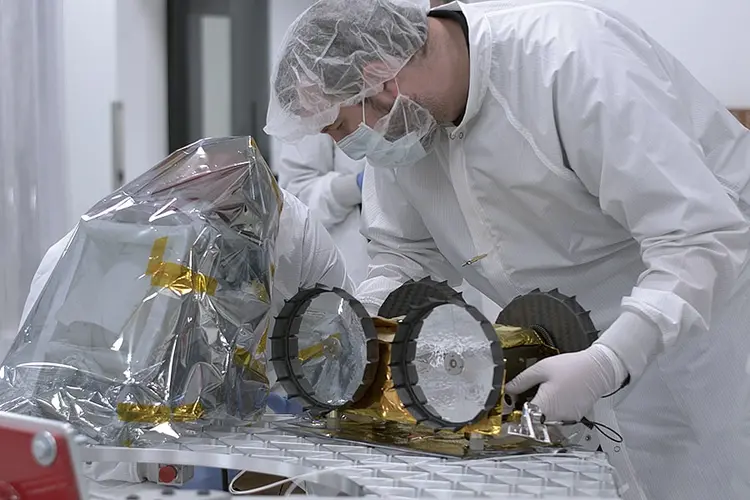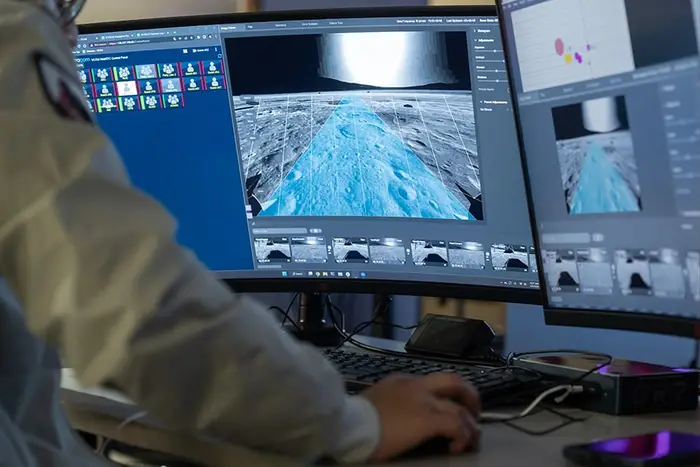
Iris Rover Team Prepares for May Launch
Media Inquiries
May the Fourth be with you.
Carnegie Mellon University will have its eyes on the sky on May 4, and not because of Star Wars.
Iris(opens in new window), a tiny, lightweight lunar rover built by CMU students, and the MoonArk, a collaborative sculpture project led by faculty, students and alumni, are set to launch on Thursday, May 4. United Launch Alliance (ULA), whose Vulcan Centaur rocket will carry the two university projects to the moon, announced the date as the earliest possible launch date.
"Hundreds of students have poured thousands of hours into Iris. We've worked for years toward this mission, and to have a launch date on the calendar is an exciting step," said Raewyn Duvall(opens in new window) (pictured), commander of the Iris mission. "Iris will open up lunar and space exploration by proving that a tiny, lightweight rover built by students can succeed on the moon."
Iris and MoonArk will both travel aboard the Peregrine lunar lander, which will fly on the ULA rocket. The lander, designed by CMU spinoff Astrobotic(opens in new window), will carry 14 payloads including Iris, MoonArk and projects for NASA and other customers. CMU is the only university with payloads aboard the lander.
The rocket will launch from Cape Canaveral Space Force Station in Florida for its monthlong flight to the moon. Once Peregrine has landed, Iris and MoonArk will deploy to the surface, where Iris will conduct a 60-hour mission — taking photos and sending them back to Earth as it rolls along.
The Iris mission ticks many "first" boxes with its trip to the moon. It will be the first American lunar rover, the first student-developed rover, the smallest and lightest rover, and the first with both a carbon fiber chassis and wheels. The Iris mission demonstrates what is possible, and could chart the future of planetary exploration.
"In space, what matters is what flies, and soon you'll see irrefutable proof that what Carnegie Mellon has accomplished in planetary exploration matters a great deal," said William "Red" Whittaker(opens in new window), the Founders University Research Professor in the Robotics Institute(opens in new window) and a planetary robotics pioneer.
Students will control and monitor Iris from Carnegie Mellon Mission Control on the university's Pittsburgh campus. They will work in shifts to stay in constant contact with the rover during its mission. For weeks, the Iris team has conducted mission simulations, getting comfortable with the controls and working out what to do in any situation.
The MoonArk project will be the first museum on the moon. The 10-ounce cylinder comprises four small chambers made of titanium, platinum and sapphire that contain hundreds of images, poems, music, nano-objects, mechanisms and samples from Earth. Collectively, these items tell complex narratives integrating the arts, humanities, sciences and technologies. MoonArk represents the work of 18 universities and organizations, 60 team members and more than 250 contributing artists, designers, educators, scientists, engineers, choreographers, poets, writers and musicians.
A second, identical MoonArk is part of the permanent collection(opens in new window) at the Smithsonian National Air and Space Museum.
The announced launch date will allow ULA to complete its preflight testing and accommodate the timing needed by the Peregrine lander for its mission. The date, May 4, also happens to coincide with an unofficial holiday for Star Wars fans as it is a play on the franchise's catchphrase, "May the force be with you."
The Iris team prepares during a mission simulation inside Carnegie Mellon Mission Control.
In preparation for our upcoming launch of @cmu_iris, we have begun conducting multi-day 24 hour full mission simulations in the @CarnegieMellon Mission Control Room. @astrobotic @ulalaunch pic.twitter.com/fbaYFa4QMK
— Iris Lunar Rover (by Carnegie Mellon University) (@cmu_iris) January 9, 2023
— Related Content —





